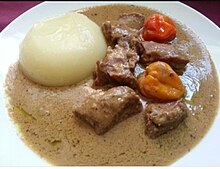Peanut stew
 Tigadèguèna | |
| Alternative names | Groundnut stew |
|---|---|
| Type | Stew |
| Place of origin | Senegal,Mali |
| Region or state | West Africa |
| Main ingredients | Meat(lamb,beef,orchicken),tomatoes,onions,garlic,cabbage,leaforroot vegetables,peanuts |
Peanut steworgroundnut stew,also known asmaafe(Wolof,mafé,maffé,maffe),sauce d'arachide(French) ortigadèguènais astewthat is a staple food inWestern Africa.[1]While maafe is a dish from Senegal, tigadéguéna originates from theMandinkaandBambara peopleofMali.[2]
The proper name for it in theMandinka languageisdomodahortigadegena(lit. 'peanut butter sauce,' wheretigeis 'peanut,'degeis 'paste,' andnais 'sauce') in Bamanankan.[3]
Domodahis a sauce also used byGambians,whose name has been borrowed from theMandinka language.[4][5]InSenegaldomodah ordomodarefers to flour-thickened soup or stew, which is different frommaafethat uses peanut paste.[6]Senegalese maafe is a favorite dish among several Senegalese and Gambian ethnic groups, it has become the national dish in Mali as well as a popular dish acrossWest Africa,even outsideWest Africasuch as inCameroonandFrance.[7]
Variants of Senegalese maafe appear in the cuisine of nations throughoutWest AfricaandCentral Africa.It is very similar togroundnut soup.It may be prepared withlamb,beef,chicken,or without meat.[8][9][1][10]In Ghana, this stew is usually eaten withfufu.[10]
Variations
[edit]
Recipes for the stew vary widely, but commonly includechicken,tomato,onion,garlic,cabbage,andleaforroot vegetables.Other versions includeokra,corn,carrots,cinnamon,hot peppers,paprika,black pepper,turmeric,cumin,and otherspices.Maafe is traditionally served with whiterice(inSenegal,Mauritania,Guinea-BissauandGambia),fonioorto(milletdough) inMali,tuwooromo tuo(riceor millet dough) in NorthernNigeria,Niger,and NorthernGhana,couscous(as West Africa meets the Sahara, in Sahelian countries), orfufuandsweet potatoesin the more tropical areas, such as the Ivory Coast.Um'bidois a variation using greens, whileGhanaianmaafe is cooked with boiled eggs.[11]"Virginia peanut soup", a variation of Senegalese maafe even traveled with enslaved Africans to North America.[12]
Senegalese maafe
[edit]Maafe or mafé was improved from bassi guerte, a peanut butter sauce served with chere a Senegalese couscous on millet basis.[13]Malian tigadèguèna and Senegalese maafe being in taste and consistency different.[14]Unlike Malian tigadèguèna, which is traditionally more watery and prepared with unrefined shea butter, the type of maafe prepared and consumed inSenegalis a rice-based dish with a creamy peanut paste sauce, tomato, oil, meat, onion, garlic, vegetables and spices which give it a particular flavor. Senegalese maafe is not only the national dish in Mali and Gambia, it is also prepared in various countries in West Africa as well as outside the African continent. In The Gambia, it is called domodah.[15]
The Gambia
[edit]Domoda is a type of groundnut stew found inThe Gambia.[16]Domoda is prepared using ground peanuts or peanut butter, meat, onion, tomato, garlic, seasonal vegetables and spices.[16][17]It has been described as one of thenational dishesof The Gambia.[17]Domoda is typically served over rice, and is also sometimes served overfindi,a grain that is similar to couscous in consistency.[17]
Gallery
[edit]-
Groundnut stew prepared with fried groundnut paste, fish, eggs and hotpalm oil
-
Senegalese maafe served with rice
See also
[edit]References
[edit]- ^abCollective, The Moosewood; Scherer, J. (2013).Moosewood Restaurant Favorites.St. Martin's Press. p. 127.ISBN978-1-250-00625-7.RetrievedSeptember 9,2016.
- ^James McCann. Stirring the pot: a history of African cuisine, p132. Ohio University Press, 2009ISBN 0-89680-272-8
- ^"The Hirshon Malian Peanut Stew – Tigadegena".✮ The Food Dictator ✮.2016-09-22.Retrieved2020-05-29.
- ^James McCann. Stirring the pot: a history of African cuisine, p132. Ohio University Press, 2009.ISBN0-89680-272-8
- ^Emma Gregg, Richard Trillo. Rough guide to the Gambia, p39. Rough Guides, 2003.ISBN1-84353-083-X
- ^Saine, Abdoulaye (2012).Culture and customs of Gambia.Greenwood.ISBN978-0-313-35911-8.OCLC881315512.
- ^Crenn, Jeylin (1983).The African cuisine cookbook.
- ^Dorinda Hafner."Maafe - Chicken And Peanut Stew - Mali".Chef2Chef culinary portal.Archived fromthe originalon 2007-02-03.Retrieved2007-03-03.
- ^Ester Goody (2012)."Ghanaian Groundnut Stew".In Jessica Kuper (ed.).The Anthropologist'S Cookbook.Taylor & Francis. pp. 81–83.ISBN978-1-136-16789-8.
- ^abWright, C.A. (2012)."Groundnut Stew from Ghana".Best Stews in the World: 300 Satisfying One-Dish Dinners, from Chilis and Gumbos to Curries and Cassoulet.Harvard Common Press. p. 408.ISBN978-1-55832-787-0.
- ^Um'bido (greens & Peanuts) RecipeArchived2016-03-03 at theWayback Machine
Ghanaian Maafe: My Changing Memories of Mafe - ^Where Settlers, Slaves and Natives Converged, a Way of Eating Was Born,By Geneva Collins,Washington PostStaff Writer, Wednesday, May 9, 2007; Page F01.
- ^François Sigaut, Hélène Franconie, Monique Chastanet (2010).Couscous, boulgour et polenta transformer et consommer les céréales dans le monde.p. 161.
{{cite book}}:CS1 maint: multiple names: authors list (link) - ^N'Diaye Haas, Joséphine.Cuisine sénégalaise.
- ^Niang, Cheikh (2022).Cuisine d'Afrique et d'ailleurs.
- ^abJacob, J.; Ashkenazi, M. (2014)."The Gambia".The World Cookbook: The Greatest Recipes from Around the Globe, 2nd Edition: The Greatest Recipes from Around the Globe.Vol. 1. ABC-CLIO. p. 481.ISBN978-1-61069-469-8.
- ^abcSaine, Abdoulaye (2012).Culture and Customs of Gambia.Culture and customs of Africa. Greenwood. p. 95.ISBN978-0-313-35910-1.
Further reading
[edit]- Kitchen Window: My Changing Memories of Mafe,Afi-Odelia E. Scruggs. NPR.org, November 9, 2005
- EATS & DRINKS:Incomparable Senegalese,Tama Janowitz,New York Press,(nd). Credits Maafe as a Malian dish.
- The Modern Soul of African Cuisine,Food Product Design news, 05/04/2007.
- chicken and vegetables braised in peanut sauce.Gourmet Magazine,January 2002. Credits Maafe as a Bambara dish.
External links
[edit]- Mafe recipe
- variation of the Senegambian recipe
- Um'bido recipe,variation of maafe
- Malian recipe:Dorinda Hafner,A Taste of Africa(2002)
- Senegalese maafe recipe,ascribing a Malian source
- Mafe recipe,Ivory Coast variation
- Maffé à la viande,with lamb(in French)


